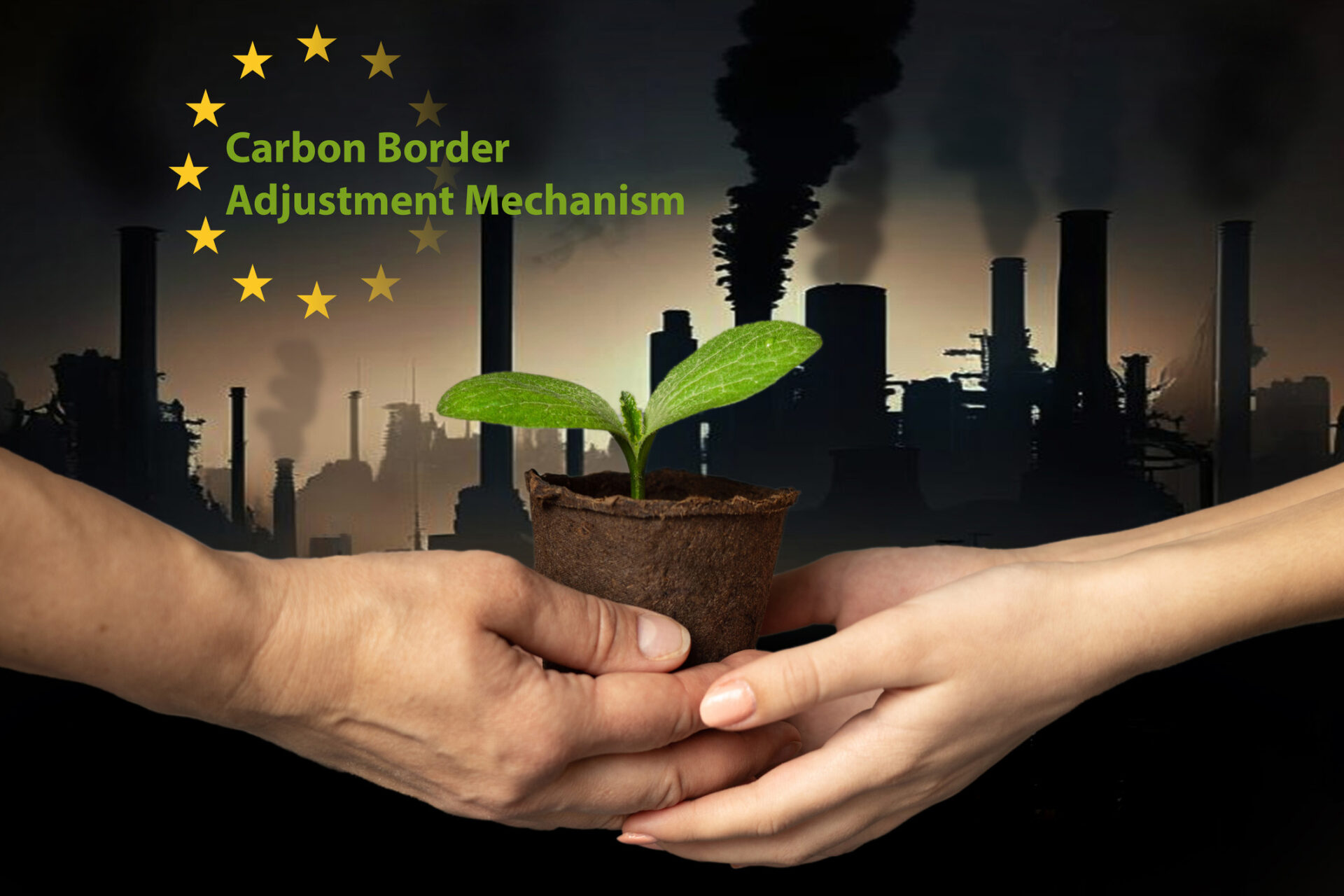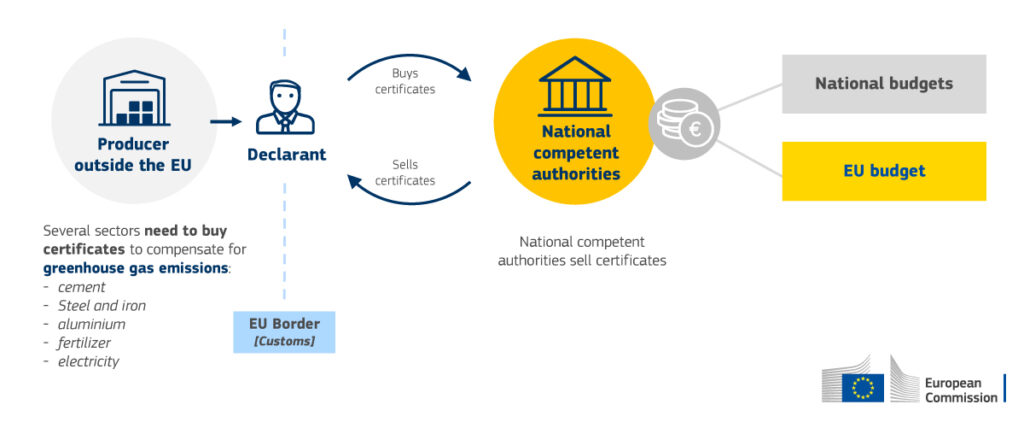The New Frontiers: CBAM
The Carbon Border Adjustment Mechanism
27th January 2024

The Carbon Border Adjustment Mechanism (CBAM) is a landmark policy initiative of the European Union. It was launched in October 2023 to combat climate change by ensuring that imports into the EU meet the same stringent environmental standards as those imposed on EU producers. This mechanism is crucial to aligning economic activity with climate objectives and promoting sustainable practices across the global supply chain.
However, there are concerns that CBAM could be perceived as a trade barrier rather than a green measure. This is because it imposes additional costs on imported goods that do not meet EU environmental standards. Therefore, it is essential to examine CBAM’s intentions, potential impacts, and the delicate balance it seeks to strike between environmental responsibility and global trade fairness.
A comprehensive analysis of CBAM is necessary to understand its implications for international trade and environmental policy. It is crucial to evaluate the mechanism’s ability to promote sustainable development and protect the environment while ensuring that it does not hinder fair competition or negatively impact vulnerable economies.
Understanding the Mechanics of CBAM:
The European Union (EU) has implemented an innovative carbon pricing system called the Carbon Border Adjustment Mechanism (CBAM), which is applied to specific imports such as cement, steel, aluminium, fertilizers, electricity, and hydrogen. This system aims to combat the practice of carbon leakage, which is when businesses outsource production to countries with lax environmental regulations. By imposing a cost on the carbon emissions associated with these goods, the EU aims to create a level playing field for businesses operating in Europe and those operating in countries with less stringent environmental regulations. The implementation of CBAM is a significant step in the EU’s efforts to prevent carbon emissions and promote a more sustainable future. The system ensures that the EU’s ambitious climate policies do not unintentionally create an economic advantage for regions with less strict environmental standards, thereby protecting the planet for future generations.

The Dual Goals of CBAM:
Preserving Environmental Goals: The Carbon Border Adjustment Mechanism (CBAM) is a powerful tool in the fight against climate change. It plays a critical role in safeguarding the EU’s ambitious climate targets by preventing carbon leakage. With the CBAM in place, we can ensure that carbon-intensive goods imported into the EU are subject to the same carbon pricing mechanisms as those produced within the EU. This creates a level playing field for businesses, incentivizes more sustainable practices, and ultimately helps to secure a greener future for us all.
Promoting Fair Competition: The Carbon Border Adjustment Mechanism (CBAM) has been designed to promote fair competition in the global market by ensuring that European Union (EU) industries, which bear the cost of complying with local environmental regulations, are not at a disadvantage compared to their non-EU counterparts. CBAM aims to level the playing field by ensuring that non-EU producers are held to the same environmental standards as EU producers, thereby reducing the risk of carbon leakage and encouraging the transition towards a greener economy. By doing so, CBAM not only supports the EU’s ambitious climate targets but also helps to establish a more sustainable and equitable global economy.
Advantages and Challenges:
Advantages:
- Global Environmental Impact: CBAM could drive a worldwide shift towards greener production practices, significantly reducing global carbon emissions.
- Economic Incentives: It creates economic incentives for countries outside the EU to establish carbon pricing mechanisms, potentially leading to a global standardization of environmental practices.
Challenges:
- Trade Tensions: CBAM may be perceived as a protectionist tool, potentially straining trade relations and inciting disputes under WTO regulations.
- Operational Complexity: Accurately assessing the carbon footprint of imports is a complex task, raising questions about the feasibility and efficiency of CBAM’s implementation.
Transitional Phase and Future Adjustments:
The transitional phase until 2026 is vital for fine-tuning CBAM. This period allows for the resolution of teething issues, ensuring the mechanism’s effectiveness, fairness, and compliance with international trade laws. Stakeholder engagement, especially with trade partners, during this phase is crucial to address concerns and establish a common ground.
Wider Global Context:
- Developing Countries’ Dilemma: There’s a significant concern about the disproportionate impact of CBAM on developing economies. These countries may face challenges in meeting CBAM’s standards due to resource constraints, necessitating a thoughtful approach that includes support mechanisms.
- Exemptions and Collaborations: The possibility of exemptions for nations with parallel carbon pricing systems and collaborations to help countries transition to greener technologies could be key to CBAM’s global acceptance.
- Role in Global Climate Strategy: As a pioneering initiative, CBAM has the potential to become a template for other regions, thereby contributing to the collective effort to achieve the Paris Agreement’s objectives.

The CBAM entered into application in its transitional phase on 1 October 2023, with the first reporting period for importers ending 31 January 2024.
The CBAM will initially apply to imports of certain goods and selected precursors whose production is carbon intensive and at the most significant risk of carbon leakage: cement, iron and steel, aluminium, fertilizers, electricity and hydrogen. With this enlarged scope, CBAM will eventually – when fully phased in – capture more than 50% of the emissions in ETS-covered sectors. The objective of the transitional period is to serve as a pilot and learning period for all stakeholders (importers, producers and authorities) and to collect useful information on embedded emissions to refine the methodology for the definitive period.
The gradual phasing in of CBAM over time will also allow for a careful, predictable and proportionate transition for EU and non-EU businesses, as well as for public authorities. During this period, importers of goods in the scope of the new rules will only have to report greenhouse gas emissions (GHG) embedded in their imports (direct and indirect emissions), without making any financial payments or adjustments. Indirect emissions will be covered in the scope after the transitional period for some sectors (cement and fertilizers), on the basis of a defined methodology outlined in the Implementing Regulation published on 17 August 2023 and its accompanying guidance.
The Implementing Regulation on reporting requirements and methodology provides some flexibility regarding the values used to calculate embedded emissions on imports during the transitional phase. Until the end of 2024, companies will have the choice of reporting in three ways:
- Full reporting according to the new methodology (EU method)
- Reporting based on an equivalent method (three options)
- Reporting based on default reference values (only until July 2024)
As of 1 January 2025, only the EU method will be accepted, and estimates (including default values) can only be used for complex goods if these estimations represent less than 20% of the total embedded emissions. The Commission published default values on 22 December 2023. This report from the EU’s Joint Research Centre (JRC) fed into preparing those default values.
The Commission has also developed dedicated IT tools to help importers perform and report these calculations, as well as in-depth guidance, training materials and tutorials to support businesses when the transitional mechanism begins. While importers will be asked to collect fourth-quarter data as of 1 October 2023, their first report must only be submitted by the end of January 2024.
Once the permanent system enters into force on 1 January 2026, importers will need to declare each year the quantity of goods imported into the EU in the preceding year and their embedded GHG. They will then surrender the corresponding number of CBAM certificates. The price of the certificates will be calculated depending on the weekly average auction price of EU ETS allowances expressed in €/tonne of CO2 emitted. The phasing-out of free allocation under the EU ETS will occur in parallel with the CBAM phasing-in in 2026-2034.
Conclusion:
The Carbon Border Adjustment Mechanism is a significant experiment in marrying environmental policy with economic principles. While it navigates the complex waters of international trade and environmental law, its success will largely depend on its implementation, global cooperation, and adaptation. As the world watches CBAM’s progress, its role in fostering a sustainable economic model that harmonizes climate goals with fair trade will be crucial. The EU’s bold step with CBAM could either pave the way for a new era of environmentally conscious trade policies or serve as a learning point in the ongoing journey towards global sustainability.
Sources:
- European Commission website: https://taxation-customs.ec.europa.eu/carbon-border-adjustment-mechanism_en
- European Parliament website: https://multimedia.europarl.europa.eu/en/video/the-carbon-border-adjustment-mechanism-explained_N01_AFPS_230524_FIT3
- World Trade Organization website: https://www.bruegel.org/blog-post/european-unions-carbon-border-mechanism-and-wto
News Articles and Analyses:
- The New York Times: https://www.nytimes.com/interactive/2022/12/13/climate/climate-footprint-map-neighborhood.html
- The Financial Times: https://www.reuters.com/markets/carbon/eu-strikes-deal-world-first-carbon-border-tariff-2022-12-13/
- The Economist: https://www.economist.com/finance-and-economics/2023/10/01/how-carbon-prices-are-taking-over-the-world
Think Tanks and NGOs:
- Bruegel: https://www.bruegel.org/event/carbon-border-adjustment-mechanism-greening-eu-trade
- Carbon Tracker: https://carbontracker.org/
- World Resources Institute: https://www.wri.org/
write to us journey@trst01.com